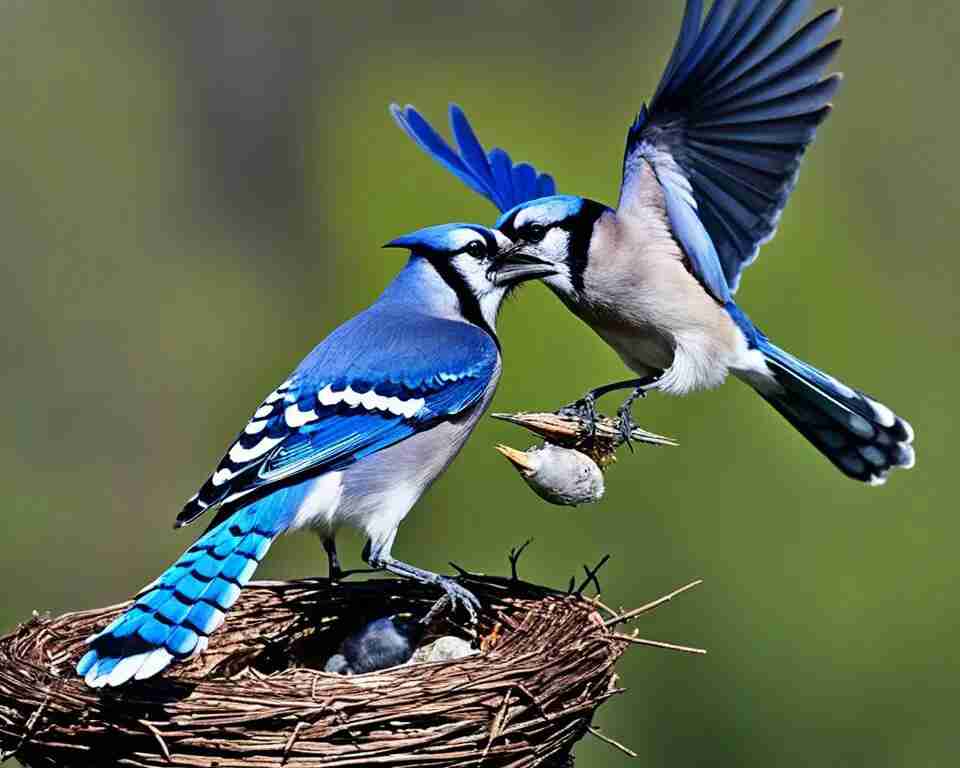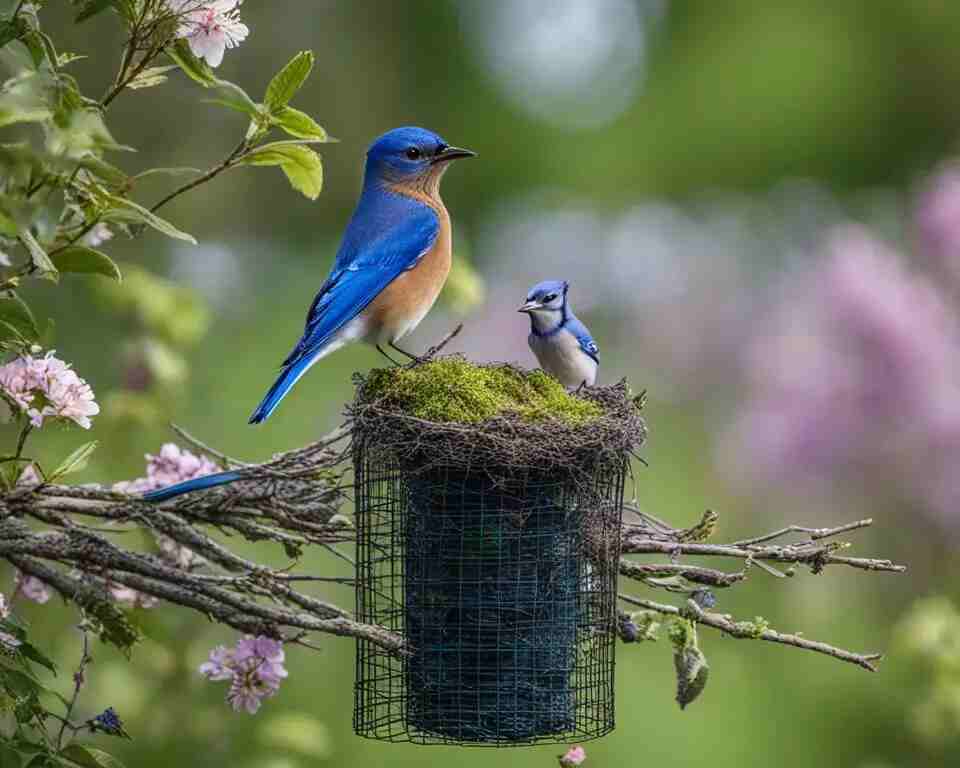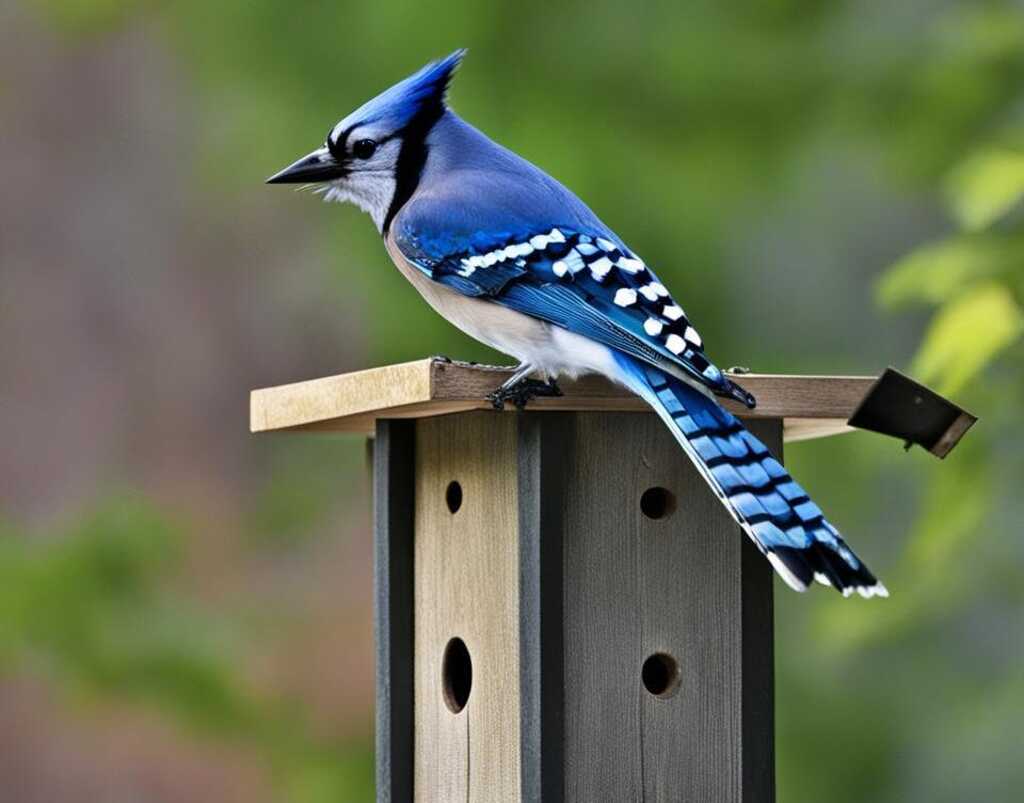Blue jays are fascinating birds known for their vibrant blue feathers and distinctive crests. However, their behavior towards other birds, including bluebirds, can sometimes be aggressive and puzzling.
But, why are blue Jays harrassing my bluebirds? If you’ve witnessed blue jays harassing your beloved bluebirds, it’s important to understand the reasons behind this behavior and how to protect your feathered friends.
Table of Contents
- 1 Key Takeaways:
- 2 Understanding Blue Jay Behavior
- 3 Busting the Myth
- 4 Encouraging Blue Jay-Specific Feeding Areas
- 5 Additional Ways to Safeguard Bluebirds
- 6 Understanding Mobbing Behavior
- 7 Conclusion
- 8 FAQs:
- 8.1 Why do blue jays harass bluebirds?
- 8.2 What is the behavior of blue jays?
- 8.3 Do blue jays eat smaller birds or nestlings?
- 8.4 How can I create bluebird-friendly spaces?
- 8.5 What seeds should I choose to deter blue jays?
- 8.6 How can I encourage blue jay-specific feeding areas?
- 8.7 What are additional ways to safeguard bluebirds?
- 8.8 What is mobbing behavior?
- 8.9 How does understanding mobbing behavior help in blue jay and bluebird interactions?
- 8.10 How can I protect bluebirds from blue jay aggression?
- 9 Source Links
- 10 Author
Key Takeaways:
- Blue jays are social birds that form tight-knit bands to protect food sources and watch out for predators.
- Their aggression towards bluebirds is a natural behavior driven by their need to safeguard their own and other birds in their community.
- During winter, when food is scarce, blue jays’ protective behavior becomes more prominent.
- Dispelling the myth that blue jays eat smaller birds or nestlings, their aggression is mainly focused on defending their food and territory.
- Creating bluebird-friendly spaces, providing specialized feeders, choosing the right seeds, and establishing blue jay-specific feeding areas can help safeguard bluebirds.

Understanding Blue Jay Behavior
Blue jays are fascinating birds known for their social behavior and complex relationships with each other. They often form tight-knit bands to protect food sources and watch out for predators. This behavior is especially evident during winter when food is scarce.
Blue jays have a strong sense of protecting their own and will even band together to fend off larger predators such as hawks or owls. They exhibit a remarkable level of cooperation and communication within their bands, allowing them to effectively defend their territories and ensure the safety of their group.
While blue jays may appear aggressive towards smaller birds, it is important to understand that they are not trying to kill or eat them. Instead, they are more focused on safeguarding their food sources and maintaining their dominance in the area. Their behavior of chasing away smaller birds is a natural instinct to protect their resources.
Blue jays have distinct feeding habits as well. They are known to enjoy larger seeds like sunflower seeds and have a preference for peanuts and cracked corn. By understanding their feeding habits, we can provide appropriate food sources that attract blue jays and help alleviate their interactions with other bird species.
Blue Jay Feeding Habits
- Eats larger seeds like sunflower seeds
- Enjoys peanuts and cracked corn
Understanding blue jay behavior is essential in finding ways to coexist with them peacefully. By providing a balanced environment that meets the needs of all bird species, we can create a harmonious backyard ecosystem.
| Blue Jay Behavior | Blue Jay Feeding Habits | Bluebird Nesting Habits |
|---|---|---|
| Blue jays form tight-knit bands to protect food sources and watch for predators. | They eat larger seeds like sunflower seeds and enjoy peanuts and cracked corn. | Bluebirds prefer nesting in natural cavities or specially designed birdhouses. |
| They exhibit cooperative behavior by banding together to defend their territories. | Bluebirds lay eggs in nests made of grass, twigs, and other fine materials. | |
| Blue jays chase away smaller birds to safeguard their food sources. | Nesting habitats should be located in quiet areas away from disturbance. | |
| They have a keen sense of protecting their own and will defend against larger predators. | Bluebirds prefer nesting at slightly higher heights, around 5-10 feet above ground. |
Busting the Myth
There is a myth surrounding the feeding habits of blue jays, suggesting that they prey on smaller birds or nestlings. While it is technically true that blue jays may occasionally consume smaller birds, this behavior is rare and not their primary feeding habit.
In most cases, when blue jays interact aggressively with other small birds, it is to defend their food source rather than actively hunting for food. It is crucial to dispel this myth and understand that their aggression is predominantly focused on protecting their territory and food.
To further clarify, blue jays do not actively seek out smaller birds as prey. Instead, they primarily feed on a varied diet that includes seeds, nuts, fruits, and insects. Their feeding habits revolve around readily available food sources and fulfilling their nutritional needs, rather than preying on other bird species.

Encouraging Blue Jay-Specific Feeding Areas
Creating specific feeding areas for blue jays can help reduce their aggression towards other birds. By setting up a separate feeding station away from the feeders meant for smaller birds, you can provide a designated space for blue jays to enjoy their favorite foods.
Offer a mix of peanuts, millet, cracked corn, and sunflowers that blue jays love, ensuring a reliable and plentiful food source for them.
When blue jays have their own feeding area, they are more likely to stay there and leave the other feeders alone. This helps create a more peaceful and balanced environment for other bird species in your backyard.
To further encourage blue jays to stick to their designated space, consider setting up a separate bird bath as well.
Showcasing the Blue Jay-Specific Feeding Area
| Feeder Type | Food Options |
|---|---|
| Hopper feeder | Peanuts, cracked corn |
| Platform feeder | Sunflower seeds, millet |
By providing various types of feeders and a diverse range of food, you can attract blue jays to their designated feeding area while still providing for the nutritional needs of other bird species.
By creating a specific space for blue jays, you can encourage them to feed in an area where their natural feeding habits can be fulfilled and minimize their interactions with smaller birds.
This approach promotes harmony among different bird species in your backyard while ensuring that blue jays have access to the food they enjoy.
Additional Ways to Safeguard Bluebirds
In addition to creating bluebird-friendly spaces, it is important to explore other ways to protect and conserve bluebirds in your yard. By taking specific actions and making conscious choices, you can support the well-being and thriving population of these beautiful birds.
1. Provide Suitable Nesting Habitats
To encourage bluebirds to nest in your yard, it is crucial to provide suitable habitat options. Consider installing bluebird houses in strategic locations, such as near open fields or in areas with low human activity.
These houses mimic natural nest cavities and offer a safe haven for bluebirds to raise their young. Additionally, maintaining and preserving natural nest cavities, like old trees with existing cavities, can also attract bluebirds and provide them with suitable nesting habitats.
2. Avoid the Use of Pesticides
Pesticides pose a significant threat to bluebirds and other bird species. These chemicals can contaminate food sources, disrupt reproductive cycles, and cause long-term harm to bird populations.
To protect bluebirds and promote a healthy ecosystem, it is essential to avoid using pesticides in your yard. Instead, opt for natural and organic pest control methods that do not harm birds or their habitats.
3. Promote Bluebird Conservation
Supporting organizations dedicated to bluebird conservation can make a significant impact. Consider becoming a member of local or national bluebird societies, participating in citizen science projects focused on bluebirds, or donating to conservation efforts.
These actions contribute to research, advoc7acy, and habitat protection, all of which are critical for the long-term survival of bluebirds.
4. Educate Others About Blue Jay and Bluebird Interactions
Increasing awareness about the interactions between blue jays and bluebirds can help dispel misconceptions and foster a better understanding of their behaviors. Share information with your friends, family, and community about the natural instincts and protective nature of blue jays.
Encourage others to create bluebird-friendly spaces and adopt bird-friendly practices in their own yards. By collectively spreading knowledge, we can create a supportive environment for bluebirds and maintain a harmonious coexistence between different bird species.
By implementing these additional measures alongside creating bluebird-friendly spaces, you can contribute to the conservation and protection of bluebirds. Your efforts will not only benefit these captivating birds but also promote the overall health and diversity of your backyard ecosystem.
| Safeguarding Actions | Method |
|---|---|
| Provide Suitable Nesting Habitats | Installing bluebird houses Maintaining natural nest cavities |
| Avoid the Use of Pesticides | Choose natural pest control methods |
| Promote Bluebird Conservation | Become a member of bluebird societies Participate in citizen science projects Donate to conservation efforts |
| Educate Others | Share information about blue jay and bluebird interactions Encourage bird-friendly practices |

Understanding Mobbing Behavior
When it comes to bird behavior, mobbing is a common occurrence, and blue jays are no exception. Mobbing happens when smaller birds collaborate to fend off larger birds or predators from their territories or nests. Blue jays, known for their assertiveness, are often seen engaging in mobbing behavior to protect their breeding territories and young.
Mobbing is a natural behavior for birds and should not be misunderstood as an act of aggression aimed at causing harm to larger birds. Instead, it is a strategy employed by smaller birds, including blue jays, to collectively intimidate and drive away potential threats to their nests and territory.
Understanding mobbing behavior provides valuable insights into the complex interactions between blue jays and other bird species. It highlights the lengths to which these birds will go to safeguard their offspring and maintain the integrity of their breeding grounds.
| Benefits of Mobbing Behavior | Example |
|---|---|
| Increased safety for nestlings | Smaller birds mobbing a predator near their nests |
| Stronger defense against predators | Blue jays joining forces to drive away a larger bird of prey |
| Preservation of breeding territory | Collective mobbing to deter intruding birds |
Mobbing behavior serves as a survival instinct for blue jays and other birds, ensuring the protection of their offspring, defending their territories, and maintaining a stable environment for successful breeding. It is crucial to recognize and appreciate this behavior as we observe the fascinating interactions between blue jays and their avian counterparts.
Conclusion
Blue jay aggression towards bluebirds is a natural behavior driven by their need to protect their food and territory. These social birds form tight-knit bands to safeguard their valuable resources and watch out for predators. While the aggression might seem like bullying, it is actually a way for blue jays to ensure the survival of their own and other birds in their vicinity.
To mitigate their aggression and protect bluebirds in your backyard, it is crucial to understand blue jay behavior and create bluebird-friendly spaces. By providing specialized feeders that prevent larger birds like blue jays from accessing the food meant for smaller birds, you can create a peaceful feeding environment. Choosing the right seeds, such as nyjer and safflower, can also deter blue jays from visiting those feeders.
Additionally, encouraging blue jay-specific feeding areas with a variety of favorites like peanuts, millet, cracked corn, and sunflowers can help minimize their dominance over other bird feeders. By respecting their natural behavior and creating a harmonious backyard ecosystem, we can coexist with blue jays while safeguarding bluebirds and other bird species.
FAQs:
Why do blue jays harass bluebirds?
Blue jays exhibit aggressive behavior towards bluebirds to protect their food and territory. Understanding the nature of blue jays and taking steps to create bluebird-friendly spaces can help safeguard bluebirds.
What is the behavior of blue jays?
Blue jays are social birds that form tight-knit bands to protect food sources and watch out for predators. They are known to engage in mobbing to drive away larger birds or predators. Blue jays have specific feeding and nesting habits.
Do blue jays eat smaller birds or nestlings?
While technically true, it is rare for blue jays to eat smaller birds or nestlings. Most of the time, if they attack other birds, it is to defend their food source rather than actively hunting them for food.
How can I create bluebird-friendly spaces?
To create bluebird-friendly spaces, you can provide specialized feeders for smaller birds, such as tube or caged tube feeders, and offer a diverse range of seeds to attract different bird species. Setting up separate feeding stations for blue jays can also help minimize their aggression towards other birds.
What seeds should I choose to deter blue jays?
Blue jays love larger seeds like sunflowers. Choosing seeds like nyjer and safflower for other feeders can help discourage blue jays from visiting them, as these seeds are less appealing to them.
How can I encourage blue jay-specific feeding areas?
You can set up a designated feeding area for blue jays away from the feeders meant for smaller birds. Offering a mix of peanuts, millet, cracked corn, and sunflowers that blue jays love can provide them with a reliable food source and discourage them from dominating other feeders.
What are additional ways to safeguard bluebirds?
Apart from creating bluebird-friendly spaces, you can install bluebird houses or maintain natural nest cavities to provide suitable nesting habitats. Avoiding the use of pesticides in your yard is also important to protect bluebirds and other bird species.
What is mobbing behavior?
Mobbing behavior is when smaller birds swoop and dash at larger birds or predators to drive them away from their territories or nests. Blue jays are known to engage in mobbing behavior as a way to protect their breeding territories and young.
How does understanding mobbing behavior help in blue jay and bluebird interactions?
Understanding mobbing behavior provides insights into the interactions between blue jays and other bird species. It helps to recognize that blue jays are not trying to cause harm to larger birds but are acting to protect their own.
How can I protect bluebirds from blue jay aggression?
Understanding the behavior of blue jays and implementing strategies like creating bluebird-friendly spaces, choosing the right seeds, and encouraging blue jay-specific feeding areas can help mitigate blue jay aggression and safeguard bluebirds in your backyard.


